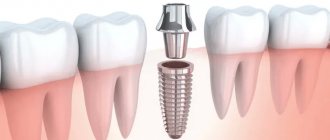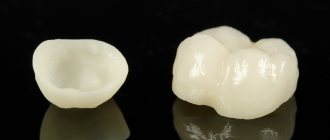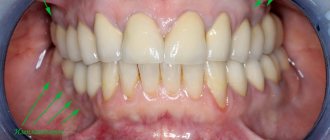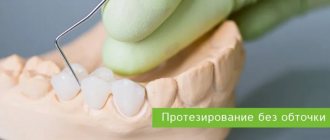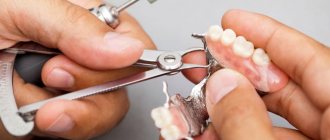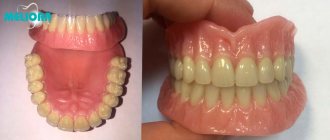Dental implantation in dentistry is the implantation of an artificial root into the jaw bone followed by the installation of a crown (immediately or after the implant has been implanted). The procedure is popular around the world and is used for complete or partial edentia. Only this technique stops bone tissue atrophy. But there are many myths and incorrect judgments around it, because of which less reliable methods of dentition correction are often chosen - removable or bridge dentures.
Methods for restoring missing teeth
Every patient who has decided to undergo dentures is concerned with the question “Which method of tooth restoration is better?” First, you need to understand exactly what kind of dental prosthetics we are talking about - the reconstruction of a damaged or destroyed tooth, or the replacement of a missing dental unit (or several).
In the second case, the answer is clear – the ideal option is dental implantation. There are many arguments for installing dentures or dental implants. Classic dentures involve fixing the orthopedic system with support from adjacent teeth. Implantation is the most preferable and natural way to preserve the dentition, since it allows you to restore not only the top of the tooth, but also its root part.
More about manipulation
Implantation is carried out in several stages. First, the doctor implants an artificial root into the gum. Here in the future he will install a prosthesis. It takes a certain amount of time for the implant to heal. During this period, it is clear whether the body will accept the implant or reject it.
Once the healing period has passed, the dentist installs a crown. It must completely match the appearance of neighboring teeth. This applies not only to shape, but also to color. Before implantation, the patient visits a dentist and a therapist with various specializations. If at least a couple of months have passed since the tooth was removed, you can begin prosthetics. After this period, the bone tissue of the jaw, as well as the gums, are restored.
Dental implantation - what is it?
Dental implantation is a method of restoring dentition by inserting dental implants into the jawbone. An artificial support made of medical titanium is screwed into the bone tissue, acting as a tooth root. An abutment is attached to the titanium root, which serves as the basis for fixing the orthopedic structure.
The type of dental implants is selected according to the clinical situation and depends on the type of bone tissue and many other factors. Modern technologies and materials make the installation of an artificial root the most comfortable, safe and reliable process, and a properly selected implant will last a lifetime.
Are dental implants harmful?
After tooth extraction, bone loss begins within six months. In the absence of constant pressure (load), it resolves. Experts agree - the implant is considered the only structure that can evenly load the tissue. Wearing removable dentures and bridges does not stop the process.
Dental implants restore the jaw system by replacing the top and root of the tooth. The structures promote proper nutrition of bone tissue cells, which adapt to constant loads. If the effect on the bone is not enough, the tissue weakens, dissolves, and decreases in size. The higher the load, the denser and larger the bone mass. Therefore, when implants are installed, it increases.
Implants are made from bioinert materials that are safe for the body and therefore do not cause any harm. And due to the ability to restore bone tissue, they bring only benefits.
Expert opinion
Emir Romanovich Omerelli
Maxillofacial surgeon, implantologist
Experience: more than 13 years
The main rule when restoring completely or partially lost teeth is the correct reconstruction of the dentition from a functional and aesthetic point of view. From an aesthetics point of view, the prosthesis must fit harmoniously into the dentition, look natural, have an anatomically correct shape and ensure proper closure of the dentition. The functional side of the issue determines the ability of the orthopedic design to fully participate in the process of chewing and speech, as well as correctly distribute chewing loads. Permanent prosthetics on implants fully meets all requirements, allowing you to restore the full functionality of the dental system even with complete edentia.
How is dental implantation performed?
The implantation of artificial roots is carried out under local anesthesia, and the installation technology itself is divided into the following stages:
- Preparatory
The doctor determines which method will be used in a given clinical case, how many and what implants will be used. Prepares the oral cavity for intervention. Complete sanitation is carried out - hygienic cleaning, treatment of caries, replacement of old crowns and fillings, elimination of periodontal problems.
- Surgical
Depending on the implantation method, the artificial root is installed by incision or micro-puncture of the gum, forming a bed of the required length and width into which the implant is screwed. With one-stage implantation, an artificial root is installed in the tooth socket immediately after its extraction.
- Abutment installation
An abutment is installed on the implant - a special structure that acts as an adapter between the titanium root and the prosthetic structure.
- Orthopedic
Based on an individual impression, an orthopedic structure (crown, bridge) is made in a dental laboratory, which is fixed to the abutment.
If there is insufficient bone tissue, before installing implants, surgery is performed to build up the jaw bone (osteoplasty, sinus lift).
MYTH 3: Implants often fail
Outdated disc and plate implant models caused many problems for patients due to complex, traumatic fixation into the bone. They did have a high rejection rate (50%). Such models have not been used for a long time, but the stereotypical opinion remains. The latest generation implantation systems are made from biocompatible, hypoallergenic material (medical titanium, zirconium oxide). Thanks to the root-shaped shape of the implant, similar to the anatomy of a natural tooth root, and a special active coating, successful engraftment is ensured in 98-99% of cases.
Implantation - arguments for!
- Does not require grinding of adjacent healthy teeth.
- Completely restores chewing function.
- Impeccable aesthetics - artificial teeth completely imitate natural ones.
- Allows you to fill the gap of any number of teeth.
- No changes in the gingival contour - even after a long time, the gums do not recede and do not expose the area where the crowns connect to the abutment.
- The structure of the titanium pin activates the growth of bone tissue in the area of implantation and stimulates tissue metabolism processes.
- The prosthetic structure placed on the abutment can be easily replaced if necessary.
- The ability to choose the ideal implantation technology for a specific patient.
- The ability to restore the dentition without additional jawbone building.
- Reliability, long service life (25 years or more).
- Absence of destructive changes in speech and taste.
Complex cases
In fact, in my work I often have to approach problem solving quite creatively. Sometimes the cases are so unusual that you don’t even believe in a good result. But I cannot leave the patient alone with this problem, realizing that no one may take on this work. Moreover, I have a team with whom we take on these cases. We try, and the most incredible thing is that we succeed.
I'll tell you one case. The patient came to me from a distant corner of Russia with a very difficult and neglected situation. The patient experienced a colossal loss of bone tissue. The orthopedic dentist and I understood that people no longer expect high aesthetics, but still really want to live a full life.
We convened a consultation, I remember asking the opinion of many of my colleagues - the majority gave quite reasonable advice to abandon this case and not risk their reputation. But I still took it. Of course, I assessed all the risks, and we discussed them with the patient.
The decision was made rather unconventionally - we decided to reduce the total number of implants and do complex All-on-5 implantation instead of All-on-6. In the end, everything turned out even better than we expected.
Another story of progress. 8 years ago I performed basal implantation on a patient. Even then the bone was very thin, and I won’t say that it came as a surprise to me when the patient again approached me with a request for reimplantation. After studying 3D tomography, it turned out that the implants had fallen into the sinus; as a result, our team of doctors decided to perform All-on-4 zygomatic implantation. Fortunately, the patient was lucky here too and everything healed perfectly.
However, I realized that the new knowledge that was gained through many courses, practices, and seminars provided the most important thing - the opportunity to apply non-standard solutions and help people leave with QUALITY work done.
Dental prosthetics - what is it?
Prosthetics are necessary for complete or partial loss of teeth. Installed dentures can be removable or non-removable (permanent).
- The convenience of the former lies in the fact that you can remove and install them yourself without the help of a dentist. Removable dentures are attached to the oral cavity using clasps (hooks) and attachments (locks).
- Fixed prosthetics involves the final fixation of the orthopedic system in the mouth and its constant wearing. Such dentures do not need to be removed, and in functionality and appearance they are identical to the patient’s own teeth.
Dental prosthetics differs from implantation in the technology of installing an orthopedic structure. Fixed dentures are fixed in the mouth with support from adjacent teeth, which (in most cases) are previously depulped and ground down. Removable dentures are fixed by suction to the gum or with special gels.
How is dentures performed?
Fixed and removable dental prosthetics includes the following stages:
- Preparatory
A thorough preparation of the oral cavity is carried out - current problems with teeth and gums are eliminated, preliminary orthodontic treatment is carried out (bite correction, etc.). If permanent dentures with veneers or lumineers are planned, teeth whitening is required. To securely fix a crown or dental bridge, depulpation and grinding of the supporting teeth are required. The dentist makes a decision about the need to depulpate a tooth based on the diagnostic results.
- Manufacturing of dentures
In a dental laboratory, an orthopedic system is made using individual impressions from the patient’s teeth.
- Installation
During fitting, the finished orthopedic system is adjusted to the required parameters, the shade and texture of the artificial teeth are adjusted, and the prosthesis is finally fixed in the mouth.
What is more profitable – prosthetics or implantation?
To understand what is more financially profitable – installing an implant or a traditional prosthesis, let’s compare the following options for dental prosthetics:
| Restoration of 1 tooth | Restoration of 3 teeth |
|
|
Every 8-10 years, the bridge will need to be reinstalled, and taking into account the fact that in 90% of cases the restoration of supporting teeth will be necessary, plus inflation, the amount of re-prosthetics increases by an order of magnitude. At the same time, one should not forget about the rapid loss of bone tissue in the area of missing teeth - this is fraught with subsidence of the gums, exposed roots, loosening and loss of supporting units.
Dental implants will last a lifetime. Since during implantation the chewing load is distributed evenly over the entire jaw, and not just over the installed crowns, replacement of the orthopedic system will be required no earlier than in 15-20 years; a huge bonus to this is the preservation of adjacent teeth and bone tissue.
That is, if we take into account only what is paid directly for the procedure now, then traditional dentures are cheaper, but in the future, implantation turns out to be much more profitable, more reliable and permanent.
Technology advantage
- The technique allows you to solve the problem of the absence of a dental unit in the shortest possible time.
- The number of seams is minimal.
- No bone grafting is required.
- In one session, 1 damaged tooth is replaced with a strong new one. The bite does not change.
- Minimal recovery period.
For more reliable implantation of the structure, it is not recommended to load the crown on the day of the session. Speed, lack of discomfort, and the possibility of performing the procedure without bone grafting are the main advantages of one-step dental implantation. The service life of the implant is at least 20 years.
Questions and answers
Basal implantation with dentures (1 jaw)!!!! How can I make an appointment with you for a consultation?
Basal implantation with dentures (1 jaw)!!!! How can I make an appointment with you for a consultation?
Hello! You can sign up for a free consultation on dental implantation by calling + or 8 800 333-53-41 (free for regions). Our specialists will select a convenient time for your consultation and answer all additional questions about basal dental implantation. Sincerely, Patient Support Center SIMPLADENT++ 78
As a result of illness (fluorosis), he lost a large number of teeth. Orthopedists in our city offer removable dentures. Tell me, what prosthetic options are possible in my case?
As a result of illness (fluorosis), he lost a large number of teeth. Orthopedists in our city offer removable dentures. Tell me, what prosthetic options are possible in my case?
Hello! In your case, in order to recommend possible options for dental restoration, it is necessary to first analyze the image and also conduct an examination of the oral cavity. It is necessary to understand why you were not offered to have dental bridges or dentures on implants, why the orthopedist suggested that you install removable bridges. If you have such an opportunity, we suggest that you attend a free consultation at one of our clinics so that our doctors can conduct a direct examination, since a remote consultation still does not give the full picture. You can make an appointment with our specialists by calling the numbers listed below. Sincerely, Patient Support Center SIMPLADENT++ 78-800-333-53-41
Other questions
Other jobs
Minuses
Contraindications
Implantation, like any other surgical operation, has limitations:
- diseases of the heart, endocrine system;
- oncology;
- mental disorders;
- allergic reactions to medications;
- multiple inflammations in the oral cavity.
But the listed diseases in remission are considered relative prohibitions, not absolute.
High price
The relatively high cost is an obvious disadvantage. In our Center, the price for a set of procedures for installing 1 implant is from 60,000 rubles . For comparison, a removable denture for 2 jaws costs 36,000 rubles. But the implant is installed for life, and the prostheses are constantly changed. Costs are recovered in the long term.
Surgical intervention
Implantation requires surgery, which not all patients are ready for. In our Center, the problem is solved with anesthesia, which relieves the patient’s discomfort. If a person is very nervous or afraid, we use sedation - implantation during sleep.
Examples of work “Before” and “After”
ROOTT implantation with immediate loading and removable prosthetics (June 2015)
Case: periodontitis, destruction of remaining teeth, severe atrophy of bone tissue.
Implantation and prosthetics of one tooth
Case: loss of a front tooth due to an injury that occurred 3 years ago; the patient had not visited the clinic before.
